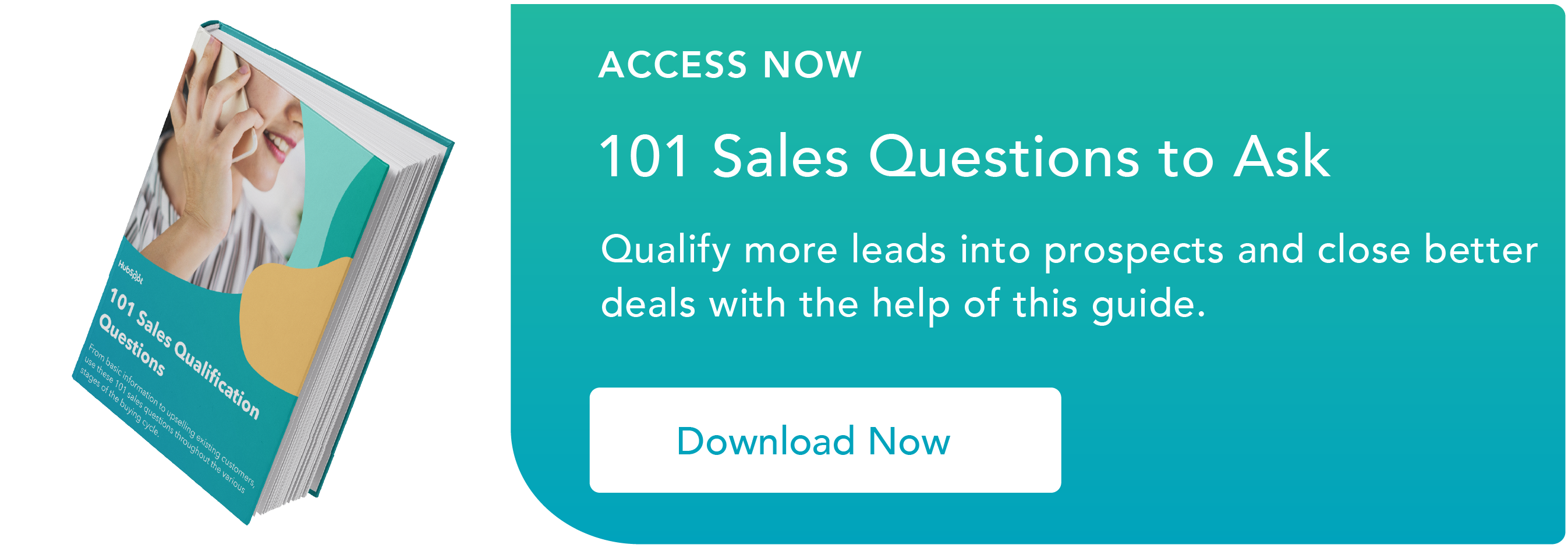How do you determine if a prospect's a good fit for your product or service?
Sales qualification is the answer.
Not every lead is a good fit for a product or service — no matter how strongly a salesperson believes they are (or wants them to be). Buyers don't buy just because they have a serious need, a looming deadline, or money to burn. They buy because of a combination of all of these factors, and more.
During the sales qualification process, salespeople can't determine a fit based on one of these criteria. They have to establish a fit based on all relevant factors.
While the specific sales questions a rep asks will depend on the product or service they sell, here are some solid conversation starters that can help you recognize who's a successful customer in the making, and who's better suited for another solution.
Free Download: 101 Sales Qualification Questions [Access Now]
Sales Qualification
Sales qualification is a part of the sales process where salespeople determine whether or not a prospect is a good fit for the product or service they're selling. Salespeople have an ideal customer profile and compare the prospect's characteristics to the profile. If the prospect is not a good fit, the salesperson won't sell to them.
.png)
Free Guide: 101 Sales Qualification Questions
101 Questions to Ask Contacts When Qualifying, Closing, Negotiating, and Upselling.
- Budget Questions
- Business Impact Questions
- Competitor Questions
- And More!
Download Free
All fields are required.
.png)
1. What business problem are you solving with this offering?
Change isn't easy, and businesses don't overhaul systems and processes for the fun of it. If there's no real problem the prospect is trying to solve, there's no real reason for them to buy. Establishing a business pain (either from a known issue or from a problem the prospect wasn't even aware of) before diving into other questions can help you understand what the problem is and how you can help.
2. What's prompting you to do something about it now?
Prospects who have recently experienced a significant trigger event, such as a change in leadership, market shift, legal issue, or major company development, will have more incentive to address the problem now rather than later.
3. What has prevented you from trying to solve the problem until now?
Do other priorities keep taking precedent? Is there a bend in the path to a solution? Learning what has historically blocked the way to fixing this problem can help the salesperson understand where it falls on the prospect’s list of priorities, and reveal potential pitfalls.
4. Have you tried to solve this problem in the past? If so, why didn't that solution work?
Alternatively, it could be that the prospect has attempted a solution before, but for whatever reason, that patch didn't stick. Digging into the past could reveal that what you thought was a perfect fit isn't actually so great — or that your prospect needs what you sell ASAP.
5. What happens if you do nothing about the problem?
If the answer is "well, not much," the prospect doesn't have a pressing need. At this point, the salesperson should either disqualify the lead, or explain to them what might happen if the problem goes unresolved.
6. Do you have a budget allocated for this project? If not, when do you expect to have one?
Money isn't everything, but it certainly has bearing on whether or not a prospect is worth pursuing — so make sure you qualify on budget sooner rather than later. The specific number doesn't matter as much as the fact that your offering's price and the prospect's ability to pay are within the same ballpark. For instance, if your product costs $1 million and the prospect can only afford $100, the sale isn't going to go through so it’s best to disqualify the prospect.
7. How does the purchase approval process work?
This question can uncover additional financial decision-makers that need to be looped in sooner rather than later. For example, who is the final decision maker and how soon can you get them on a call? Having this information upfront can help the deal go a lot smoother later on.
8. What are you currently spending to solve this issue?
If the prospect already has a competitive solution in place, the salesperson can get a benchmark of how much they're used to spending. And with a firm number, the salesperson can then ask if the prospect would be comfortable going higher.
Here's how former HubSpot Sales VP Pete Caputa phrases this question in his sales qualification calls:
"We've established that your goal is X and that you're spending Y now to achieve X. But it's not working. In order to hire us, you will need to invest Z. Since Z is pretty similar to Y and you're more confident that our solution will get you to your goal, do you believe it makes sense to invest Z to hire us?"
9. How would the decision process work with an offering like this? What would be your role in the process, and the roles of others on the decision team?
Is the person you're talking to the decision-maker? Or is the decision-maker someone else? Make sure you understand the dynamics of the buying committee and who has authority over what. For example, while one stakeholder could be the "ultimate" signer, another might be the financial approver.
10. Has your company ever considered/used a product like this before? If so, what happened?
The best way to make sure you don't repeat history is to study it. Compare your buyer's expectations and perceptions of "good" and "bad" to your offering. If there's a significant mismatch, it's best to disqualify the prospect now before you spend any more time on the deal.
11. What hurdles could crop up and derail this project?
Too many potential potholes might not make the deal worth pursuing. For instance, there may be a change in staffing on the prospect’s end and the decision-maker could change during the course of the sale. It might be best to hold off on pursuing the lead until their team is ready to move forward.
12. What challenges do you think you'll come up against with the plan I've laid out? Do you think you'll struggle with Z or Y?
When is a prospect who has the requisite need, authority, and money to buy as well as the correct solution timeline not a good prospect? When they won't be able to execute the plan you've laid out. While some offerings require more elbow grease than others, every new product or service requires some effort on the prospect's part to get it up and running. And if the prospect is unwilling to put in the work, they're not going to get results. Find this out early so you're not dealing with an unhappy customer later.
13. What other solutions are you evaluating?
In some cases, an additional vendor is brought in after a prospect has already decided on another in the name of due diligence or to put price pressure on the incumbent provider. Listen carefully to the prospect's answer to assess whether their engagement with you isn't totally authentic.
.png)
Free Guide: 101 Sales Qualification Questions
101 Questions to Ask Contacts When Qualifying, Closing, Negotiating, and Upselling.
- Budget Questions
- Business Impact Questions
- Competitor Questions
- And More!
Download Free
All fields are required.
.png)
14. What does success look like to you, both in terms of qualitative and quantitative results?
Whether a prospect becomes a happy customer or a detractor largely depends on their expectations. If their definition of success does not line up with what your offering can provide, it might be time to disqualify.
15. What does solving this problem mean to you personally? What do you stand to gain if the issue was solved? What do you stand to lose if it goes unresolved?
An internal champion can often be more effective at corralling the buying committee around a particular product or service than the salesperson herself. The more skin the prospect has in the game, the more likely they are to be a helpful advocate.
16. Based on what you've seen so far, do you think our offering could be a viable solution for your problem?
Peppering mini agreements or commitments throughout the buying process — even in the qualification call — can lay the groundwork for the ultimate agreement at the end.
17. When do you need a solution in place?
If there's a firm date the problem absolutely needs to be fixed by, the salesperson can then work backward to determine a signing date.
18. Do you agree that the next step is X by Y date? When would be a good time on or around that date to schedule a call or meeting?
This isn't so much a qualification question as a sales best practice. Every sales interaction should end with a next step tied to a date. If the buyer is truly committed to moving forward, they won't have any trouble agreeing to a second meeting or call. Interest: secured. Prospect: Qualified.
19. Do you currently have a solution in place? If so, why are you switching?
It's always good to know whether they have a solution in place already — and what they like/dislike about it. Not only is this helpful to your sales strategy, but it's great intelligence gathering on your competitors.
20. Is this a pain point for everyone on your team? Is there anyone who might serve as a barrier to this solution?
Find out who your potential roadblocks will be as soon as possible. Is the whole team on board? Is your prospect the only champion? These questions will help you build a roadmap to success and tell you how much support your champion will need to sell this solution internally.
21. Tell me about your average day and how this solution would impact that daily work.
This is a great ice-breaker. It's also a subtle way of finding out whether your prospect is a decision-maker, what level of responsibility and buying power they hold, and whether they've purchased a solution like yours before.
Prospect and Lead Qualification Checklist
- Awareness
- Budget
- Authority
- Need
- Roadblocks
- Timeline
Sales lead qualification is a process that can be iterated and improved by just about every sales manager out there. Frameworks like BANT, FAINT, ANUM, and CHAMP are praised and criticized, but they all share some of these same underlying principles.
1. Awareness
The first step to qualifying a lead is to briefly assess how aware they are of your industry and product. If your company sells a niche product or is creating a new product category, this step will be critical as you determine whether the prospect will be a good fit as a customer.
Another reason you should ask the prospect how aware they are of what you sell is that they’ll need to itemize this expense in a category within their budget. If they aren’t familiar with what it is you offer, this could create roadblocks down the line when you ask about their budget for this type of expense.
2. Budget
All sales have an exchange of money, no matter what. The companies your leads work for are probably meticulous about budgets, as they should be, in order to run a successful organization. Early on, figure out how much of that budget is allocated to the team your prospect works on — and what percentage of that budget is dedicated to the category of products and services you offer.
3. Authority
Who exactly is making the final decision in this sale, and who are they influenced by within their organization? Keep in mind, the contact information on the lead form may not be the person making the final decision, so as you ask these qualifying questions, you may have to run through this checklist again when you meet with someone who has decision-making authority.
4. Need
It’s one thing for a single employee at a company to identify a need for what you sell, but if their team, and sometimes even the entire company, don’t find a need for your product or service, the deal may not be worth pursuing. Qualifying a lead based on need goes hand in hand with authority, so as you move further along in the sales process, continue to revisit these two criteria. You’ll want to check that:
- Everyone’s in alignment on what the team’s/company’s priorities are, and
- The problems your product or service solves are relevant to the work the prospect is directly responsible for.
.png)
Free Guide: 101 Sales Qualification Questions
101 Questions to Ask Contacts When Qualifying, Closing, Negotiating, and Upselling.
- Budget Questions
- Business Impact Questions
- Competitor Questions
- And More!
Download Free
All fields are required.
.png)
5. Roadblocks
Any good sales rep will tell you a closed deal always follows a pain point. By identifying roadblocks your prospect experiences early on, you can position your solution as a reprieve to those roadblocks. Perhaps the prospect’s team has issues with bottlenecks, productivity, or adding value to the company's revenue generation goals. Intentionally identifying this issue upfront gives you a way to add value that will be relevant to them from the first conversation, forward. Find a realistic, truthful, and ethical angle where your product can save the day, then communicate it throughout the sales process.
6. Timeline
Accurate forecasting is a significant part of the role of a sales rep, so establishing a timeline during the lead qualification process is essential. Don’t mistake asking about a timeline as an invitation to negotiate moving the deal along faster than the lead is comfortable with. This criterion simply gives you an idea of when the deal could close. If you are closing out a quarter and want to get this deal through in time to hit your quota, you could lead this part of the conversation with a suggested timeline based on what you learn about the prospect’s situation. If they agree, it’s a win-win for both parties.
Fill Your Pipeline with Qualified Prospects
Qualifying questions are a crucial part of your sales process. They help you discern whether you can help your prospect and whether continuing is a smart use of both sides' time. Customize and carefully craft each set of qualifying questions you use. The results will be well worth the effort.
Editor's note: This post was originally published in May 2020 and has been updated for comprehensiveness.
Sales Qualification




![How I use BANT to qualify prospects [+ expert tips]](https://53.fs1.hubspotusercontent-na1.net/hubfs/53/bant-questions-6606f7b6c0d9e.webp)



![21 Signs Your Buyer Is a Poor Fit [Sales Process Checklist], According to HubSpot's Former Sales Director](https://53.fs1.hubspotusercontent-na1.net/hubfs/53/Bad%20fit%20checklist.jpg)



